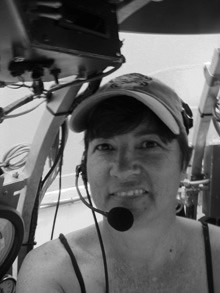Early life and education
Widder was born in Arlington, Massachusetts [4] to Dr. David Widder, a Harvard University mathematics professor, and Dr. Vera Widder, a mathematician turned stay at home mother. [5] She also had an older brother, David Charles Widder. [6]
She graduated from Tufts University magna cum laude with a B.S. in Biology, from University of California, Santa Barbara with an M.S. in Biochemistry, and from University of California, Santa Barbara with a PhD in Neurobiology, in 1982. [7]
Career
Widder was a senior scientist and director of the Bioluminescence Department at the Harbor Branch Oceanographic Institution from 1989 to 2005. [8] Certified as a Scientific Research Pilot for Atmospheric Diving Systems in 1984, she holds certifications that qualify her to dive the deep diving suit WASP [2] as well as the single-person untethered submersibles DEEP ROVER and DEEP WORKER. [9] She has made over 250 dives in the JOHNSON SEA LINK submersibles. [10] Her research involving submersibles has been featured in BBC, PBS, Discovery Channel, and National Geographic television productions. [11] [12] [13]
A specialist in bioluminescence, she has been a leader in helping to design and invent new instrumentation and techniques that enable scientists to see the ocean in new ways. These include HIDEX, a bathyphotometer, which is the U.S. Navy standard for measuring bioluminescence in the ocean, [14] and a remotely operated camera system, known as Eye in the Sea (EITS), an unobtrusive deep-sea observatory. [15] [16] [17]
In 2005, Widder co-founded the Ocean Research & Conservation Association (ORCA), a non-profit organization dedicated to protecting aquatic ecosystems and the species they sustain by developing innovative technologies and science-based conservation action. While translating complex scientific issues into engineerable solutions, Widder is fostering a greater understanding of ocean life as a means to better, more informed ocean stewardship. In September 2006 she was awarded a prestigious MacArthur Fellowship from the John D. and Catherine T. MacArthur Foundation [18] and in 2010 she participated in the TED Mission Blue Voyage in the Galapagos. [19]
In 2012, a team of scientists comprising Edith Widder, zoologist Tsunemi Kubodera and marine biologist Steve O'Shea successfully filmed a live giant squid (Architeuthis dux) in its natural habitat [20] aboard Oceanx's MV Alucia. [21]
In 2019, Edith Widder and Nathan J. Robinson filmed the first-ever footage of a live giant squid recorded in US waters. [22] It was filmed 100 miles southeast of New Orleans, Louisiana in the Gulf of Mexico. [23] This expedition was aboard the R/V Point Sur of the University of Southern Mississippi.
The 2025 documentary A Life Illuminated is about Widder. [24]
This page is based on this
Wikipedia article Text is available under the
CC BY-SA 4.0 license; additional terms may apply.
Images, videos and audio are available under their respective licenses.
